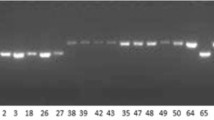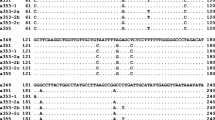Abstract
A series of PCR methods were used to detect S-RNase alleles and SFB alleles and to determine S-genotypes in 25 accessions of myrobalan (Prunus cerasifera L.). Firstly, primers flanking the polymorphic second intron were used to identify S-RNases in agarose gels. These primers amplified one or two bands per accession in 25 accessions. Then consensus primers were designed for amplifying the polymorphic first intron, unique to Prunus S-RNases, for automated fluorescent detection. Each accession produced one or two peaks. New primers were then developed to amplify the intron in the SFB gene, for detection by fluorescence. Cross-referencing PCR bands and peaks indicated 15 S-alleles were present in the 25 accessions. Cloning, sequencing and comparison with published data indicated that the amplified products were S-RNase alleles. Sequence information was used to design primers specific for each S-RNase. Full and consistent S-genotypes were obtained by cross-comparing PCR data for 23 of the 25 accessions, and two accessions appeared to have a single allele. Pollen-tube microscopy indicated function of some but not all of the S-alleles sequenced.




Similar content being viewed by others
References
Beppu K, Yamane H, Yaegaki H et al (2002) Diversity of S-RNases and S-haplotypes in Japanese plum (Prunus salicina Lindl.). J Hortic Sci Biotechnol 77:658–664
Beppu K, Takemoto Y, Yamane H et al (2003) Determination of S-haplotypes of Japanese plum (Prunus salicina Lindl.) cultivars by PCR and cross-pollination. J Hortic Sci Biotechnol 78:315–318
Bošković R, Tobutt KR (1996) Correlation of stylar ribonuclease zymograms with incompatibility alleles in sweet cherry. Euphytica 90:245–250. doi:10.1007/BF00023865
Broothaerts W (2003) New findings in apple S-genotype analysis resolve previous confusion and request the re-numbering of some S-alleles. Theor Appl Genet 106:703–714
Choi C, Tao R, Anderson RL (2002) Identification of self-incompatibility alleles and pollen incompatibility in sweet cherry by PCR-based allele typing and controlled pollination. Euphytica 123:9–20. doi:10.1023/A:1014403802677
Crane MB, Lawrence WJC (1929) Genetical and cytological aspects of incompatibility and sterility in cultivated fruits. J Pomol 7:276–301
Crane MB, Lawrence WJC (1952) The genetics of garden plants, 4th edn. Macmillan, London
Doyle JJ, Doyle JL (1987) A rapid DNA isolation procedure for small quantities of fresh leaf tissue. Phytochem Bull 19:11–15
East EM, Mangelsdorf AJ (1925) A new interpretation of the hereditary behaviour of self-sterile plants. Proc Natl Acad Sci USA 11:166–171. doi:10.1073/pnas.11.2.166
Faust M, Surányi D (1999) Origin and dissemination of plums. Hortic Rev (Am Soc Hortic Sci) 23:179–231
Gagnard JM (1954) Recherches sur les caractères systématiques et sur les phénomènes de stérilité chez les variétés d’amandier cultivées en Algérie. PhD Thesis, University of Algiers
Ikeda K, Igic B, Ushijima K et al (2004) Primary structural features of the S haplotype-specific F-box protein, SFB, in Prunus. Sex Plant Reprod 16:235–243. doi:10.1007/s00497-003-0200-x
Ishimizu T, Endo T, Yamaguchi-Kataba Y et al (1998) Identification of regions in which positive selection may operate in S-RNase of Rosaceae: implication for S-allele-specific recognition sites in S-RNase. FEBS Lett 440:337–342. doi:10.1016/S0014-5793(98)01470-7
Kato S, Mukai Y (2004) Allelic diversity of S-RNase at the self-incompatibility locus in natural flowering cherry populations (Prunus lannesiana var. speciosa). Heredity 92:249–256. doi:10.1038/sj.hdy.6800403
Lewis D (1949) Structure of the self-incompatibility gene II. Induced mutation rate. Heredity 3:339–355. doi:10.1038/hdy.1949.25
Ma R-C, Oliveira MM (2002) Evolutionary analysis of S-RNase genes from Rosaceae species. Mol Genet Genomics 267:71–78. doi:10.1007/s00438-002-0637-x
Mitov P, Gurnevski V (1977) Studies on the floral biology of some myrobalan (Prunus cerasifera) varieties. Gradinarska I Lozarska Nauka 14:20–26
Ortega E, Sutherland BG, Dicenta F et al (2005) Determination of incompatibility genotypes in almond using first and second intron consensus primers: detection of new alleles and correction of reported genotypes. Plant Breed 124:188–196. doi:10.1111/j.1439-0523.2004.01058.x
Ortega E, Bošković RI, Sargent DJ et al (2006) Analysis of S-RNase alleles in almond (Prunus dulcis): characterisation of new sequences, resolution of synonyms and evidence of intragenic recombination. Mol Genet Genomics 276:413–426. doi:10.1007/s00438-006-0146-4
Royo J, Kunz C, Kowyama Y et al (1994) Loss of a histidine residue at the active site of S-locus ribonuclease is associated with self-incompatibility in Lycopersicon esculentum. Proc Natl Acad Sci USA 91:6511–6514. doi:10.1073/pnas.91.14.6511
Rozas J, Sanchez DelBarrio JC, Messeguer X (2003) DnaSP, DNA polymorphism analyses by the coalescent and other methods. Bioinformatics 19:2496–2497. doi:10.1093/bioinformatics/btg359
Shoferistov EP (1986) Experiments on the self-pollination of myrobalan plum. Byulleten Gos Nikitiskogo Botanischeskogo Sada 61:35–39
Sonneveld T, Robbins TP, Bošković R et al (2001) Cloning of six cherry self-incompatibility alleles and development of allele-specific PCR detection. Theor Appl Genet 102:1046–1055. doi:10.1007/s001220000525
Sonneveld T, Tobutt KR, Robbins TP (2003) Allele-specific PCR detection of sweet cherry self-incompatibility (S) alleles S 1 to S 16 using consensus and allele-specific primers. Theor Appl Genet 107:1059–1070. doi:10.1007/s00122-003-1274-4
Šurbanovski N, Tobutt KR, Konstantinović M et al (2007) Self-incompatibility of Prunus tenella and evidence that reproductively isolated species of Prunus have different SFB alleles coupled with an identical S-RNase allele. Plant J 50:723–734. doi:10.1111/j.1365-313X.2007.03085.x
Sutherland B, Robbins TP, Tobutt KR (2004) Primers amplifying a range of Prunus S-alleles. Plant Breed 123:582–584. doi:10.1111/j.1439-0523.2004.01016.x
Sutherland BG, Tobutt KR, Robbins TP (2008) Trans-specific S-RNase and SFB alleles in Prunus self-incompatibility haplotypes. Mol Genet Genomics 279:95–106. doi:10.1007/s00438-007-0300-7
Tao R, Yamane H, Sugiura A et al (1999) Molecular typing of S-alleles through identification, characterisation and cDNA cloning for S-RNases in sweet cherry. J Am Soc Hortic Sci 124:224–233
Taylor HV (1949) The plums of England. Crosby Lockwood & Son, London
Ushijima K, Sassa H, Tao R et al (1998) Cloning and characterisation of cDNAs encoding S-RNases from almond (Prunus dulcis): primary structural features and sequence diversity of the S-RNases in Rosaceae. Mol Genet Genomics 260:261–268
Ushijima K, Sassa H, Dandekar AM et al (2003) Structural and transcriptional analysis of the self-incompatibility locus of almond: identification of a pollen-expressed F-box gene with haplotype-specific polymorphism. Plant Cell 15:771–781. doi:10.1105/tpc.009290
Wiersma PA, Wu Z, Zhou L et al (2001) Identification of new self-incompatibility alleles in sweet cherry (Prunus avium L.) and clarification of incompatibility groups by PCR and sequence analysis. Theor Appl Genet 102:700–708. doi:10.1007/s001220051700
Yaegaki H, Shimada T, Moriguchi T et al (2001) Molecular characterization of S-RNase genes and S-genotypes in the Japanese apricot (Prunus mume Sieb. et Zucc.). Sex Plant Reprod 13:251–257. doi:10.1007/s004970100064
Yamane H, Tao R, Sugiura A (1999) Identification and cDNA cloning for S-RNases in self-incompatible Japanese plum (Prunus salicina Lindl. cv. Sordum). Plant Biotechnol 16:389–396
Yamane H, Tao R, Murayama H et al (2000) Determining the S-genotypes of several sweet cherry cultivars based on PCR-RFLP analysis. J Hortic Sci Biotechnol 75:562–567
Yamane H, Ikeda K, Hauck NR et al (2003) Self-incompatibility (S) locus region of the mutated S 6-haplotype of sour cherry (Prunus cerasus) contains a functional pollen S allele and a non-functional pistil allele. J Exp Bot 54:2431–2437. doi:10.1093/jxb/erg271
Zhou L, Kappel F, MacDonald R et al (2002) Determination of S-genotypes and self-fertility of sweet cherry in Summerland advanced selections. J Am Pomol Soc 56:173–179
Zohary D (1992) Is the European plum, Prunus domestica L., a P. cerasifera EHRH. P. spinosa L. allo-polyploid? Euphytica 60:75–77
Acknowledgements
We thank Emma-Jane Lamont for permitting access to the P. cerasifera accessions at Brogdale National Fruit Collection. The authors gratefully acknowledge the financial support given to this project by the East Malling Trust for Horticultural Research and the University of Nottingham.
Author information
Authors and Affiliations
Corresponding author
Rights and permissions
About this article
Cite this article
Sutherland, B.G., Cerovič, R., Robbins, T.P. et al. The myrobalan (Prunus cerasifera L.): a useful diploid model for studying the molecular genetics of self-incompatibility in plums. Euphytica 166, 385–398 (2009). https://doi.org/10.1007/s10681-008-9821-3
Received:
Accepted:
Published:
Issue Date:
DOI: https://doi.org/10.1007/s10681-008-9821-3




